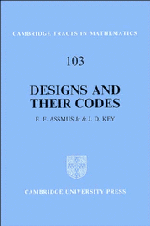5 - The standard geometric codes
Published online by Cambridge University Press: 05 October 2015
Summary
Introduction
In this chapter we present much of the classic material on the codes of those designs that arise from affine and projective geometries. When the geometry is over the field of two elements, these codes are the Reed-Muller and punctured Reed-Muller codes; otherwise they are various cases of the class of generalized Reed-Muller codes. The description of these codes as precisely the codes of the geometries — with the minimum-weight vectors as the incidence vectors of the blocks of the geometric design in question — is the work of Delsarte [80, 81], Delsarte, Goethals and Mac Williams [83] and Goethals and Delsarte [105]. We have reworked this material and simplified the development. Since several of the proofs are rather technical, we will not give them here; we will, however, indicate exactly how the code of the geometry can be obtained as a generalized Reed-Muller code (primitive or non-primitive subfield code) and illustrate the theory with examples.
There is quite an extensive literature on the generalized Reed-Muller codes: an overall historical description, together with the main references, is given in [83], which refers to the pioneering work of Kasami, Lin and Peterson [153, 154, 155], Rudolph [249] and Weldon [292] — amongst others. The book by Blake and Mullin [42] has a detailed description of the codes based mostly on the quoted works of Delsarte et a/.; these authors also give a general description of the polynomial codes of Kasami et al. [155]. Our motivation here comes from design theory, where the geometries are the starting point and the codes are those that arise as codes of designs, as we have defined them. This is a different starting point from those mentioned above, where the codes and their various decoding algorithms were the salient features, and it is this geometric point of view which has led to the simplifications that have been achieved. An alternative approach to the one we take, an approach which may in time achieve a notational and conceptual clarity, has recently been developed. This approach to generalized Reed-Muller codes involves seeing the codes as ideals in a group algebra and it began with the work of Berman [36].
- Type
- Chapter
- Information
- Designs and their Codes , pp. 139 - 198Publisher: Cambridge University PressPrint publication year: 1992



